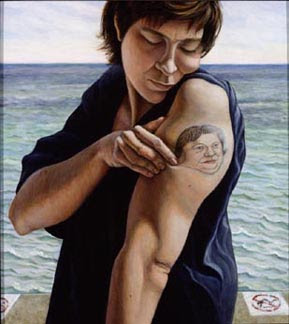
Jo Spence
The Picture of Health? Property of Jo Spence?
1982

Waafa Bilal
And Counting
2010
"…and Counting addresses this double standard as Bilal turns his own body – in a 24-hour live performance -- into a canvas, his back tattooed with a borderless map of Iraq covered with one dot for each Iraqi and American casualty near the cities where they fell. The 5,000 dead American soldiers are represented by red dots (permanent visible ink), and the 100,000 Iraqi casualties are represented by dots of green UV ink, seemingly invisible unless under black light. During the performance people from all walks of life read off the names of the dead. " -- taken from
Bilal's website
Stelarc
Extra Ear Project
Ongoing
"The 1/4 SCALE EAR is about 2 collaborative concerns. The project represents a recognizable human part and was meant to be ultimately incorporated on to the body as a soft prosthesis. However it is being presented as partial life and brings into question the notions of the wholeness of the body. It also confronts society's cultural perceptions of life with the increasing ability to manipulate living systems. Tissue Culture & Art are dealing with the ethical and perceptual issues stemming from the realization that living tissue can be sustained, grown and is able to function outside of the body. The prosthesis is now a partial life form - partly constructed and partly alive. But being only 1/4 scale it was not visually adequate to be used directly as a body augmentation. " -- taken from
Stelarc's website
Annette Messager
Mes Voeux
1988-91
 Review of an art exhibition in Second Life
Review of an art exhibition in Second LifeExample of the body deformed and abstracted through digital media
This example is a long shot, but I think it brings up some important questions in relation to the body, deformation and art. As is put forth in the chapter, part of what makes deformation so frightening is the tendency of the viewer to identify with the deformed body-- and while this deformation can indeed by frightening, it can also be pleasent. When choosing an avatar on Second Life, one is picking an abstracted representation of a body; a representation that can be entirely different than the body one possesses in real life.
------
My main question in regards to this section is how does disability factor into a conversation based around bodily difference?
I was very upset by the article we were asked to read entitled "Freak Photography". The use of the word 'freak' to loosely define all bodies that do not fit within mainstream expectation is ignorant to say the least. Throughout this article, the 'freak' is referred to as a tool for social critique, a "human curiosity", a "human oddity", and is aligned with fantasy, disease, criminality and monstrosity. No peoples with disability are interviewed, no knowledge or interest in the disability rights movement is displayed, and of the large numbers of artists with disability producing work, not one was mentioned. Peoples with disability are referred to using insulting, derogatory, and ignorant language, and the tone of this article reads as if it were written in the 1950's. While the author makes a few feeble attempts to establish alternate, non-insulting meanings of the term 'freak', she is careful not to refer to women, gays or lesbians as freaks, although it is clearly established in her thesis that signs of difference are the establishing characteristics of freakishness. I was also left wondering what difference was, ultimately, between the kind of notoriety achieved by those who participated in freak shows and the subjects of Arbus' photographs; whether in the circus or on the gallery walls, both examples are exalting signs of difference and putting them on display. Not until 20 pages into the article is the phrase 'people with disabilities' used, and then only to say that they must "now confront the problem of social and political invisibility and must seek new, less exploitative ways of gaining the public eye." People with disabilities have been doing just that for decades, and their voices should be included in any dialog that so clearly centers around their representation.
Intriguing quotes fro Art and Today:
"The breakdown of categories is a largely destructive act"
"The impulse toward deformation often centers on the distortion, fragmentation, and distortion of the human body. But deformative border crossing can also run between high and low art or realism and abstraction"






















